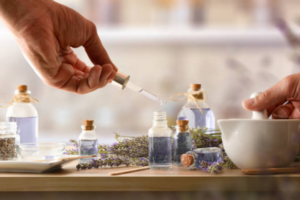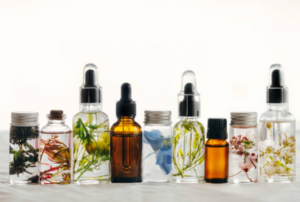Navigating Phthalates, Synthetic Musks, and Essential Oils

Have you ever closed your eyes and inhaled deeply, transported by captivating scents? Perfumes are more than just pleasant smells; they’re aromatic tapestries woven from a symphony of ingredients, each playing a crucial role in the final olfactory masterpiece. But what exactly goes into crafting your favorite scent? The world of fragrance ingredients is surprisingly intricate, with a delicate balance between captivating aromas, potential health concerns, and environmental impact. Let’s delve into the fascinating science behind creating a perfect perfume, exploring the key factors that influence fragrance composition and the trade-offs involved.
The Building Blocks of Fragrance: A Chemist’s Playground
Imagine a perfumer as a skilled composer, meticulously selecting notes to create a harmonious melody. Similarly, perfumers utilize a diverse palette of ingredients to build a fragrance. These ingredients fall into two main categories: natural and synthetic.
- Nature’s Symphony: Essential Oils
Essential oils, extracted from plants and flowers through processes like steam distillation, offer a vibrant and often therapeutic dimension to a fragrance. These concentrated liquid extracts boast unique and complex aromas, adding a touch of nature’s magic to a perfume. From the uplifting citrus notes of bergamot to the calming aroma of lavender, essential oils offer a vast array of olfactory experiences.
However, the concentrated nature of essential oils can be a double-edged sword. While some people find them invigorating, others with sensitive skin might experience irritation. Patch testing is crucial before applying essential oil-based fragrances directly to the skin. Additionally, ethical sourcing practices are crucial to ensure responsible harvesting of these precious botanical extracts and minimize environmental damage.
- Science in a Bottle: Synthetic Ingredients
Synthetic ingredients, created in labs, offer a vast palette of scents beyond what nature can provide. These lab-made wonders can replicate the alluring musk of rare animals like deer or invent entirely new olfactory experiences. Synthetic ingredients also offer several advantages. They are consistent in quality and aroma, making them ideal for ensuring a fragrance smells exactly the same every time.
Additionally, they are generally more affordable than their natural counterparts and avoid ethical concerns surrounding sourcing rare natural materials. However, some synthetic musks have raised questions about their environmental impact, as traces can linger in water sources. The good news is, fragrance science is constantly evolving, with more eco-friendly alternatives being developed all the time.

The Role of Base Notes, Heart Notes, and Top Notes
A captivating fragrance is not simply a hodgepodge of random scents. Perfumers strategically layer fragrance ingredients based on their volatility, creating a harmonious olfactory experience that unfolds over time. This layering technique utilizes three key categories of notes:
- The Foundation: Base Notes
Base notes, often derived from heavier materials like musk, sandalwood, or vanilla, form the foundation of a fragrance. They are the least volatile components, meaning they evaporate slowly and linger on the skin for hours, providing a long-lasting and sensual depth to the scent.
- The Heart: Heart Notes
Heart notes, also known as middle notes, emerge after the top notes fade and before the base notes take center stage. They typically comprise the core character of a fragrance, offering a richer and more complex aroma profile. Floral scents like rose or jasmine, as well as spicy notes like cinnamon or clove, are commonly found in the heart of a perfume.
- The Enticing Introduction: Top Notes
Top notes are the first impression of a fragrance, the light and volatile scents that hit your nose upon initial application. They are typically derived from citrus fruits, fresh herbs, or light floral notes, offering an uplifting and inviting introduction to the perfume. However, due to their high volatility, top notes tend to fade quickly, revealing the heart and base notes as the fragrance develops.
Balancing Performance, Health, and Sustainability
Creating a captivating and safe fragrance involves careful consideration of several factors:
-
Performance vs. Health: Striking a balance between fragrance longevity and potentially concerning ingredients like some phthalates is a key challenge. Phthalates were once commonly used to enhance fragrance longevity, but concerns about potential health risks, particularly for developing children and pregnant women, have led many fragrance houses to phase them out. The good news is, fragrance science is constantly evolving, with more eco-friendly alternatives being developed all the time.
-
Transparency vs. Proprietary Blends: While full fragrance disclosure on perfume bottles would be ideal, it’s not always the norm. Many brands consider their fragrance formulas to be intellectual property, keeping the exact blend of ingredients a secret. However, a growing movement towards transparency is pushing for clearer labeling on fragrance products.

Choosing a Fragrance for You
Now that you’ve peeked behind the curtain of fragrance science, you might be wondering how to translate this knowledge into choosing a perfume that perfectly complements you. Here are some tips to consider:
-
Know Your Skin Type: As mentioned earlier, essential oils can be potent and potentially irritating to sensitive skin. If you have sensitive skin, opting for fragrances with a focus on synthetic ingredients or lighter concentrations of essential oils might be a better choice. Patch testing any new fragrance before full application is always recommended.
-
Explore “Clean” Fragrances: Many brands are catering to the growing demand for clean beauty products by offering “clean” fragrances. These perfumes are typically formulated without ingredients like phthalates, parabens, and artificial colors, while still offering a captivating scent.
-
Embrace Responsible Practices: Look for fragrance houses that prioritize ethical sourcing of natural ingredients and invest in research on sustainable fragrance creation. Sustainable practices can encompass responsible harvesting of botanical extracts, minimizing water usage in production processes, and using recyclable packaging materials.
-
Find Your Olfactory Muse: Perfumes are deeply personal, and fragrance preferences can evolve over time. Don’t be afraid to experiment and explore different scent profiles – floral, oriental, citrusy, or woody – to discover what resonates with you. Many department stores offer fragrance counters where you can try samples before committing to a full bottle.
The Allure and Allure of Fragrance
The power of fragrance extends far beyond its ability to make you smell good. Scents can evoke powerful memories, influence mood, and even boost confidence.
-
The Fragrance Memory Lane: Our sense of smell is closely linked to memory. A familiar scent can instantly transport you back to a cherished childhood memory, a romantic rendezvous, or a relaxing vacation. This connection between fragrance and memory makes perfume a powerful tool for emotional well-being.
-
Mood Magic: Different scents can have a profound impact on our mood. Citrusy and floral notes are often associated with feelings of joy and optimism, while calming scents like lavender or chamomile can promote relaxation and reduce stress. Understanding how different scents affect you can empower you to use fragrance strategically to enhance your mood throughout the day.
-
Confidence in a Bottle: The right fragrance can be a powerful confidence booster. A scent that makes you feel attractive and sophisticated can translate into a more confident and outgoing demeanor.

Frequently Asked Questions:
- What is the difference between Eau de Parfum (EDP) and Eau de Toilette (EDT)?
The main difference between Eau de Parfum (EDP) and Eau de Toilette (EDT) lies in the concentration of fragrance oil in the solution. EDPs typically contain a higher concentration of fragrance oil (15-20%), resulting in a stronger and longer-lasting scent. EDTs, on the other hand, have a lower concentration (5-15%) and offer a lighter, more subtle fragrance experience.
- How long should a fragrance last?
The longevity of a fragrance depends on several factors, including the concentration of fragrance oil, the type of ingredients used, and your individual body chemistry. Generally, EDTs last for a few hours, while EDPs can linger for several hours or even all day.
- How should I store my perfume?
To preserve the integrity and longevity of your fragrance, store it in a cool, dark place away from direct sunlight and heat. Heat and light can break down the fragrance molecules, altering the scent profile.
- Can fragrance cause allergies?
Yes, some people can develop allergies to certain fragrance ingredients, both natural and synthetic. If you experience symptoms like itching, redness, or difficulty breathing after applying a fragrance, discontinue use and consult a doctor.
By understanding the science behind fragrance ingredients and the factors influencing fragrance composition, you can embark on a more informed and enjoyable journey into the world of perfumes. So next time you spritz on your favorite scent, appreciate the delicate dance of science and art that brought that captivating fragrance to life. The world of fragrance awaits – happy spritzing!

